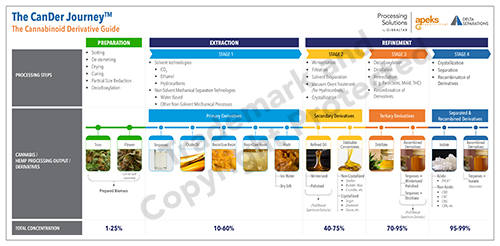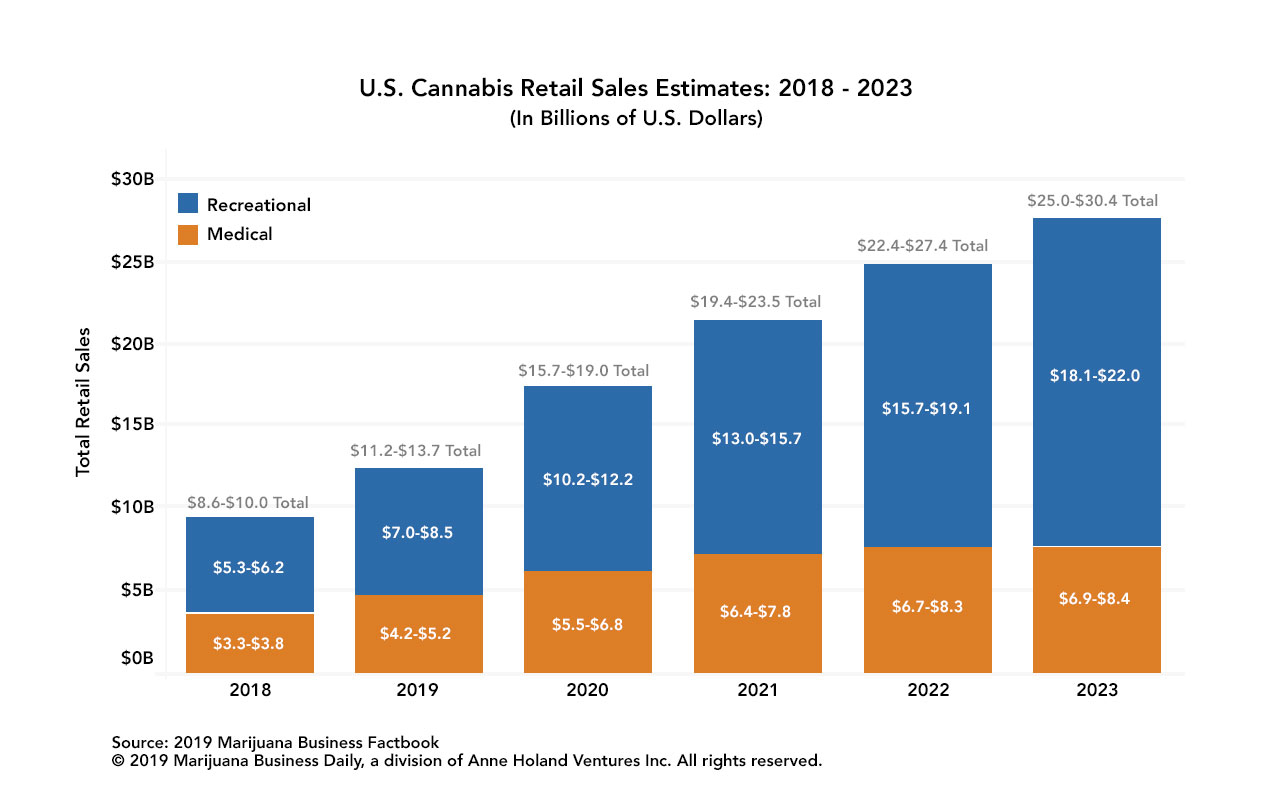How to Make Common Cannabis Derivatives
CHAPTERS
I
What is Cannabis Oil Extraction?
II
A Short History of Cannabis and Hemp Extraction
III
What are Cannabinoids?
IV
Biomass: Starting with the Right Stuff
V
Extraction Process Overview
VI
Strategic End Product Market Opportunities
VII
Common Extraction Methods and Technology
VIII
Extraction Equipment and Systems
IX
The Practical Science Behind Extraction
X
Types of Viable Business Models
XI
Top 10 Questions from the Experts
XII
Cannabis Extraction Glossary of Terms
XIII
Industry Resources and Links
Chapters
- Introduction: What is Cannabis Oil Extraction?
- A Short History of Cannabis and Hemp Extraction
- What are Cannabinoids? (THC, CBD, CBN, CBG, THCV, etc.)
- Biomass: Starting with the Right Stuff
- Extraction Process Overview (Derivatives and their Processes)
- Strategic End Product Market Opportunities
- Common Extraction Methods and Technology
- Extraction Equipment and Systems
- The Practical Science Behind Extraction
- Types of Viable Business Models
- Top 10 Questions (and Answers) from the Experts
- Cannabis Extraction Glossary of Terms
- Industry Resources and Links
How to Make Common Cannabis Derivatives
Cannabis Extraction & Refinement Process Overview
Making cannabis and hemp derivatives is an art, and, like all art forms, it takes many years of direct hands-on experience to master. To expedite your journey towards extraction mastery our in-house experts have offered up their extraction expertise. In this guide we’ll demystify how to make common derivatives by outlining all of the steps necessary to perfect the extraction and refinement processes.
(*Note, for the purposes of this guide we have broadly used the term “derivative” to describe all of the various forms of outputs and end-products that can be extracted and refined from the cannabis and hemp plant in either liquid or solid form.)
This overview covers the entire Cannabis Derivative Journey: we’ll explore all the different methods of cannabis extraction, forms of derivatives, various end-products and their current market potential.
Why Extract CBD, THC, and other ‘Minor’ Cannabinoids?
Even in the face of a pandemic, the legal cannabis and hemp derivative market is growing. If anything, COVID-19 has made the market more valuable as people seek out ways to escape from the hellscape that is 2020. The inclusion of cannabis businesses as essential businesses in many states indicate how much public opinion has changed about cannabis in the last few years. It’s only a matter of time until we reach full national legalization for all cannabis derived products. Federal legalization and continued product innovation promise a future in which mainstream retail channels adapt and embrace distribution and sale of cannabis- and hemp-derived products. And you’ll want to be ready to sell when they do.
The unprecedented growth of the cannabis industry and its all-but-certain Federal legalization presents a significant business opportunity for those willing to capitalize on it. Here’s why you should be one of those people:
- There is growing consumer demand for more sophisticated administration methods and expanding end-product offerings focused on health benefits: As consumers become more educated about the health, wellness, and recreational benefits of CBD—and THC—they’re demanding a wider scope of administration methods beyond simply smoking and vaping. In fact, a recent ProjectCBD.org survey of 3,506 people showed that, “they tended to favor CBD tinctures and topicals over traditional modes of taking cannabis, i.e. smoking and edibles.” – ProjectCBD.org

- Full federal legalization is slow but inevitable: While it’s true that full federal legalization by 2022 is a long shot, it’s not impossible. David Klein, the new CEO of Canopy Growth believes that it could happen. It’s more likely that the federal government will legalize medical marijuana by 2022, and take a few more years to legalize recreational use. State-level legalization is hitting a critical mass and that momentum could quickly prompt Federal change. Fingers crossed.
- New states opening up: Sharp sales increases in recently launched medical marijuana programs—as well as continued gains in adult-use markets—are expected to fuel much of the industry’s growth over the coming years. 11 states (plus D.C.) that have legalized cannabis for recreational purposes, and 30 have done so for medical purposes. New markets in Florida, Maryland, Oklahoma, and Pennsylvania are booming. Those gains, plus the legalization of adult-use, are more than offsetting lost medical sales in markets like Illinois, Massachusetts, and Michigan. State-level legalization is creating new revenue streams that benefit their constituencies at large.
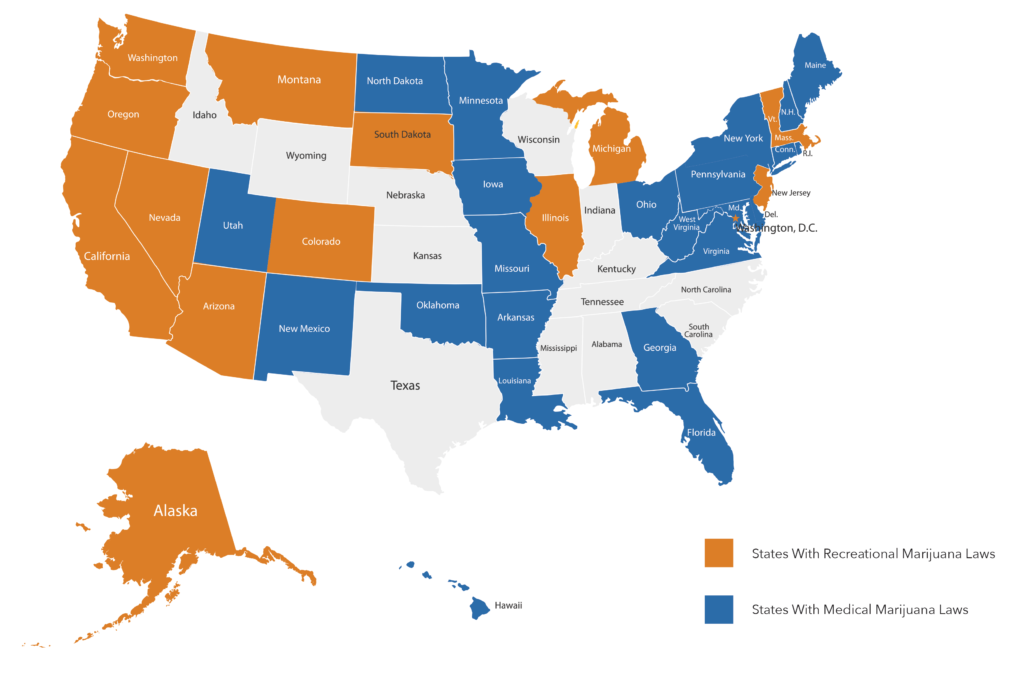
- The hemp CBD market is booming and becoming mainstream: The US CBD market grew by 706% in 2019. Global Market Insights, Inc. has recently added a new report on the cannabidiol (CBD) market which estimates the global market valuation for cannabidiol will surpass $89 billion by 2026. Many countries have legalized the growing of hemp but not marijuana, opening the way for the innovation of a wide variety of CBD end-products (from bath bombs to herbal teas to gummy bears). The relative ease with which hemp-derived CBD can be produced and distributed has driven the sector’s massive growth.
Despite the setbacks posed by a global pandemic, the US and global cannabis and CBD markets have continued to flourish. How, then, should cannabis processors keep up with consumer demand for the many derivatives that this wonderfully complex plant can produce? How do we ensure that our systems and technologies can stay on pace as the market evolves?
The short answer to these questions is to stay nimble and agile as this burgeoning–yet volatile–new industry rises out of the underground. That means being open to new multivarious cannabinoid derivative forms so you can respond to market shifts and consumer demands.
What is a Cannabis “Derivative”?
Before diving into the extraction process itself, let’s take a step back for a moment and define what we mean by the word “derivative”.
Most cannabis derivatives contain the two “major” cannabinoids:
- THC (delta-9 tetrahydrocannabinol) is an intoxicating derivative that drives recreational (or “adult”) use. It is also used widely for medicinal purposes.
- CBD (cannabidiol) is a non-intoxicating derivative more popularly used for medicinal and wellness purposes.
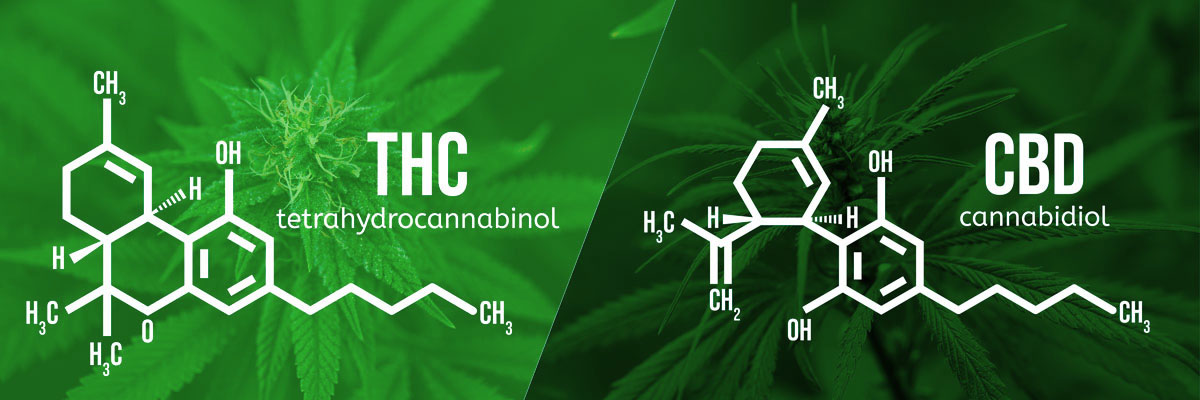
But there are a whole host of “minor” cannabinoids that are worth exploring as consumers become more sophisticated. Minor cannabinoids such as CBG, CBN, THCV, and THCA are generating a lot of interest in the marketplace. Not only are producers hunting for the next uber-popular cannabinoid, but also new studies are showing significant health benefits from these lesser known cannabinoids.
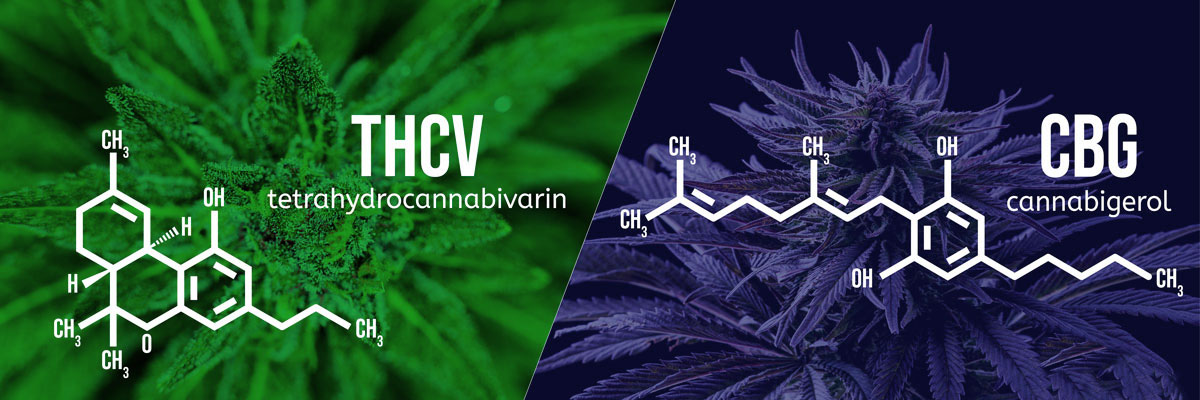
Other non-cannabinoid derivatives from the cannabis plant include desirables such as flavonoids, and terpenes, as well as “undesirable” compounds such as chlorophyll.
Terpenes are the unique compounds that give cannabis end-products their distinctive flavor and aroma ‘notes’ and are thought to contribute to psychological effects.
For the purposes of this guide we have broadly used the term “derivative” to encompass all of the varied and different concentrates, outputs, and end-product forms derived from the cannabis plant–in either liquid or solid form. This includes hemp, which is simply a cannabis plant that produces ≤0.3% THC.
Common Cannabis Derivatives and How to Make Them
What follows is an overview of the entire cannabis derivative journey; from pre-processing, through the primary stages of extraction and into further stages of refinement. This overview is by no means exhaustive but will provide you with a comprehensive overview of resulting outputs and final end-products–including their colloquial names by which they’re most well-known to consumers.
Pre-Processing Stage: Biomass or “Raw” Cannabis
Stage 1: Primary Derivatives
Stage 2. Secondary Derivatives
Stage 3: Tertiary Derivatives
Stage 4. Separated and Recombined Derivatives
Pre-Processing Stage: Biomass or “Raw” Cannabis
Pre-Processing Stage: Biomass or “Raw” Cannabis
Welcome to the preparation or pre-processing phase of the cannabis extraction journey! All extraction begins with the mature, female cannabis or hemp plant in its “raw” or natural state. Cannabis flowers, or “buds,” are the dense flower clusters that form along the upper portion of the main stems and large branches in the mature, female cannabis plant. Cannabis produces most of its trichomes—tiny hair-like outgrowths that can look like crystals—on its flowers. And trichomes are the magic factories that produce desirable compounds like cannabinoids (THC, CBD, etc.) and terpenes. All extraction methods are based on the goal of separating trichomes from the plant material to concentrate the compounds that they contain. Once the plant has been harvested, dried, and sorted, the buds are separated from the stems and stalks, and all excess leaves are trimmed (usually by hand). Finally, the flower is cured to allow any remaining moisture to equalize and flavors develop. Some of the most common and popular end-products that consumers and wholesalers seek out are found in this initial “raw” stage:- Flower (a.k.a. “Nugs” or “Buds”) is the most common and preferred form of cannabis consumption. Consumers typically process the flower by grinding it and packing it into a pipe or bong or rolling into a joint or blunt. It is also frequently sold as pre-rolled joints or “pre-rolls.”
- Trim is composed of the tiny leaves that are cut off (“trimmed”) from the flower before it’s cured. Many of these leaves are coated in trichomes, making trim a valuable byproduct. Trim does not typically include the large fan leaves, stalks, or stems removed earlier in the process. In order to maximize value, trim is commonly utilized in place of flower in later stages of processing.
Stage 1: Primary Derivatives
Stage 1. Primary Derivatives
Cannabis flower and trim can be super dense and irregular in size, making it difficult to efficiently pack into an extraction machine. This problem is often solved by milling, or grinding, the cannabis into smaller particles. After milling, the cannabis is ready for the first stage of extraction. Extraction can be performed using either solvent or non-solvent based technologies to produce the Primary Derivatives. These derivatives include a wide variety of products*:- Terpenes (a.k.a. “Terps“) are the compounds that give cannabis and its derivatives their distinctive aromas and contribute to their varied flavors. Different combinations of terpenes are widely considered to be a driving factor in the type of high that consumers experience. Terpenes are included in nearly all cannabis- and hemp-related end-products (flower, vapes, edibles, drops, dabbles, edibles, topicals, etc.) except for isolates.
- Crude Oil (a.k.a. “Crude“) is a dark, highly viscous substance similar in texture to very thick molasses. Although it is very cannabinoid-rich, containing the major (CBD and THC) and minor cannabinoids (CBN, CBG, etc.), it also still contains undesirable components such as plant particulates, solids, and waxes. Removing these components requires that crude oil be further refined. Crude oil is one of the major building blocks of the cannabis industry because most end-products start off as crude before being further refined and purified.
- Resin/Live Resin:
- Resin is usually produced using a solvent-based extraction method. It is composed of the valuable oily compounds contained in trichomes including terpenes, flavonoids, and high concentrations of cannabinoids like THC. It can also contain some undesirable elements like waxes and chlorophyll. Resin is typically further processed into dabbable concentrates.
- Live Resin is produced by taking freshly harvested cannabis and freezing it to a subcritical temperature prior to the extraction process. By skipping the pre-processing drying and curing phases the fragile but flavor-rich “live” terpenes are retained. Live resin is typically consumed in the form of vapes and dabbable concentrates.
- Rosin/Live Rosin:
- Rosin is a solventless extract obtained through the mechanical use of pressure directly on the cannabis flower. The high pressure forcefully separates the trichomes from the plant matter and results in a sticky oil. Rosin is typically consumed as a dabbable or smokeable concentrate.
- Live Rosin is made from buds that were freshly frozen immediately after harvesting. Live rosin is a strong and flavorful pure concentrate. Typically used as a dabbable or in a vape pen, live rosin can also be added to hash, kief, or flower and smoked like other combustible products.
- Hash is one of the oldest cannabis derivatives known to humankind. It is created by mechanically separating the trichomes from the plant in a number of ways. Some of the most common methods for making hash include hand rubbing (“hashish”); sifting the dry flower using a screen (“dry sift”); and using ice cold water extraction, and a series of mesh screens to break off and sift out the trichomes (“ice/water/bubble hash”).
- Ethanol (Alcohol, a.k.a. Ethyl Alcohol) is a colorless volatile flammable liquid. It’s the intoxicating agent in liquor and is also used to dilute motor fuel. Ethanol is one of the most popular solvents for cannabis extraction, is relatively easy to learn, and allows for a fairly safe extraction process.
- CO2 (Carbon Dioxide) is used to extract concentrates under high pressure and extremely low temperatures to isolate, preserve, and maintain the purity of the extracted oil. CO2 extraction requires sophisticated equipment and significantly more training than ethanol extraction. When executed correctly the end-product is safe, potent, and free of chlorophyll.
- Hydrocarbons (Butane, Propane, Methane): Another popular method is the use of hydrocarbon injection. In this method, hydrocarbons are used as a solvent to extract cannabis and terpenes. This method typically offers faster extraction rates than CO2 extraction, and hydrocarbon cannabis extraction equipment is usually less expensive to purchase. The process delivers a potent end-product suitable for dabbing.
- Edible Oils: Extra virgin olive oil, coconut oil, butter, and other edible oils can be used to extract the fat-soluble cannabinoids by gently heating decarboxylated cannabis flower directly in the edible oil. The resulting oil has a much lower potency than other extraction methods. It is seen by some as a more natural alternative to chemical based extraction methods. Cannabis-infused oils are perishable and should be stored in a cool, temperature-controlled, dark place.
- Combination of different extraction methods (e.g. injecting ethanol into CO2 stream): depending on your desired end-product, methods may be combined to increase operational efficiencies and vary end-product outputs.
- Water and/or Ice Based separation (“cold water extraction”) is ideal for producing ice water hash a.k.a. bubble hash. This method works by mechanically separating out cannabinoid-rich trichomes from the biomass through the use of water and/or ice, and an agitational force. Ice water-based extracts such as bubble hash, shatter, or crumble are ideal for dabbing and are arguably considered to be some of the highest-quality forms of cannabis concentrates available.
- Other non-solvent mechanical processes include the use of:
- A grinder or screen to produce kief, a cannabis extract similar in appearance to sugar that can then be pressed into hash via the use of a hash press.
- A rosin press that uses heat and pressure to squeeze cannabis oil out of biomass
Stage 2. Secondary Derivatives
Stage 2. Secondary Derivatives
The second stage of cannabis processing involves further refining the derivatives produced in Stage 1. Stage 2 processing increases output potency, eliminates undesirable compounds, and, again, adds value to the final end-product. Secondary Derivatives and accompanying end-products produced at this stage of refinement include:- Refined Oil is the result of winterization and polishing and is ideal for use in end-products that are enriched by a full spectrum extract such as vape cartridges, tinctures, edibles, topicals, capsules, and sublingual products.
- Dabbable Concentrates are typically smoked using glass dab rigs. There are two general categories of these types of concentrates:
- Non-Crystallized: Shatter, Budder/Wax, Crumble, etc.
- Crystallized: Sugar, Diamond, Sauce, etc.
- Winterization removes the fats, waxes, lipids from crude oil. Achieved by mixing crude oil with ethanol and freezing the solution to allow undesirable compounds to solidify, the solution is then filtered to separate or winterize waxes, lipids, and fats. Removing the ethanol from the solution is the final step. The finished product is known as winterized oil and is used in full spectrum end-products such as vape pens, tinctures, topicals, capsules, and sublingual products.
- Particulate Filtration (a.k.a. “polishing“) removes suspended particulates/adsorbents, and also enables the most efficient use of your chosen solvent. The end result of filtration is a lighter-colored cannabinoid-saturated solution that is ready to go into the evaporator.
- Solvent Evaporation is the process by which the solvent used to extract cannabinoids is removed from crude oil via evaporation.
- Vacuum Oven Treatment (for hydrocarbon solvents only) is used to separate out hydrocarbon solvents from the initial extraction, as well as influence the texture of the final concentrate. This treatment uses heat and sometimes a vacuum pump or vacuum oven depending on the desired end-product.
- Crystallization is the process by which THCA and crystallized dabbable concentrates are extracted by inducing crystallization process to crude oil and resin/live resin, respectively to produce Sugar, Diamond, Sauce, etc.
Stage 3: Tertiary Derivatives
Stage 3: Tertiary Derivatives
The third stage of the cannabis refinement journey increases the cannabinoid potency of the extracts to 70-95%. The Tertiary Derivatives and accompanying end-products produced include:- Distillates are typically used in the manufacturing of most cannabis- and hemp-related end-products: vape cartridges, edibles and beverages, tinctures, topicals, capsules, and sublingual products.
- Recombined Derivatives are combinations of derivatives such as:
- Terpenes + Winterized/Polished Oil
- Terpenes + Distillates to produce full or broad spectrum extracts typically used for vape pen cartridges.
- Decarboxylation After Extraction is used to convert acid forms of cannabinoids, like THCa and CBDa, to their more popular neutral forms, like THC and CBD. Cannabis produces cannabinoids in their acidic or “raw” forms and they must be decarboxylated in order to obtain their neutral or “active” forms. Decarboxylation is a chemical reaction that is achieved by heating cannabinoids to a temperature at which they release a carboxyl group (a carbon atom double-bonded to an oxygen atom), hence “de-carboxyl-ation.”
- Distillation uses a vacuum and controlled residence time (amount of time the solution is exposed to heat) to achieve molecular separation of target compounds from crude oil to produce a more purified and potent cannabinoid concentrate known as distillate. Distillate may still contain some non-target compounds, differentiating it from the further refined isolate.
- Remediation is the process of removing certain undesirable compounds from cannabis or hemp distillate. This process is frequently used to remove THC from hemp-derived CBD products to ensure they contain ≤0.3% THC as per federal mandate. Other undesirable compounds that can be removed during this process are microbial contaminants and molds.
- Recombination of Derivatives may include the addition of terpenes to winterized oil or distillate, depending on the desired end-product. Recombined derivatives are most commonly used to add value and effectiveness by creating full spectrum extracts.
Stage 4. Separated and Recombined Derivatives
Stage 4. Separated and Recombined Derivatives
At the fourth and final stage of the cannabis extraction and refinement journey, specific cannabinoids are isolated and/or recombined to produce isolated and recombined derivatives. The outputs of this final stage include:- Isolates are near-pure chemically isolated compounds derived from the oils produced in previous stages. Isolation of cannabinoids such as TCHA, THC, CBD, CBC, CBG, CBN, etc. enables end-product producers to have precise control over the active ingredients in their products. Isolated THCA, for example, is utilized in tinctures, topicals, capsules, pills, and sublingual drops.
- Recombined Derivatives are products created by recombining terpenes and cannabinoid isolates like THC and CBD. These products are also known as terpsolates and typically used in vape cartridges.
- Crystallization and Separation to produce near-pure isolates of cannabinoids such as TCHA, CBD, CBC, CBG, CBN, and more.
- Recombination of derivatives such as terpenes and isolates
Introducing The CanDer Journey: The Cannabis Derivative Guide
To illustrate the stages of the Cannabis Extraction and Refinement Process we created The CanDer Journey™ – The Cannabis Derivative Guide. The Guide illustrates each stage of the process, its accompanying concentration range, common derivatives, and estimated market size per end-product application.
